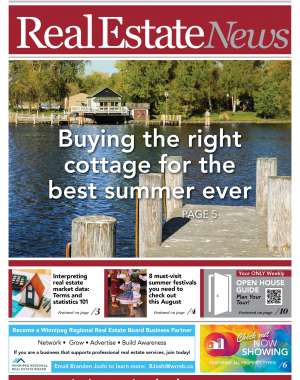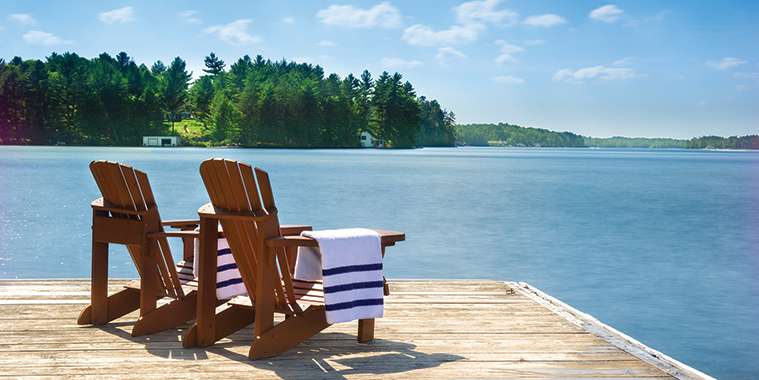Summer is in full swing and what better way to enjoy it to the fullest than sitting on your own private dock at the cottage? But why stop at summer? It’s also possible to buy a permanent residence in “cottage country” so you never have to leave.
If you’re looking to make your first “cabin” or home purchase in cottage country, here are a few important points to consider before you buy.
Property access and amenities
Whether you’re eyeing a cottage by the lake or one that’s nestled in the forest, there are many unique settings to consider when buying a rural property. Your cottage’s location can greatly impact your lifestyle, especially if you decide to live there year-round.
One of the first things you’ll likely need to determine when buying a cottage property is how you’ll be able to access the home. If you plan to live at your cottage year-round, you’ll want to ensure the roads to get to and from your residence are well maintained and accessible, especially during the winter.
How remote your cottage is will also play a role in your purchase. You may not want to feel too isolated and prefer to be fairly close to neighbours in case there’s an emergency. Or, you may prefer a completely immersive experience from that in the city, and prefer not to see any neighbours for miles.
You’ll also want to consider proximity to basic amenities, such as grocery stores, pharmacies and hospitals. Most cottage buyers prefer to be within 30 minutes of a small town where these services are available, and preferrably not more than three hours from a major urban centre. This is easily accomplished in Manitoba, where lake country is never very far away.
This close proximity is especially beneficial if you have a work-from-home arrangement. If you have to drive into the office once or twice per week, don’t have to worry about an overly long commute.
Infrastructure and winterization
Unlike a city or suburban home, cottage properties don’t always share municipal services. Instead, cottage dwellers will have to get familiar with the rural infrastructure needed to independently manage their home’s water, heating and sanitation utilities.
You have to be aware of the types of systems your home uses. Some properties feature dug or drilled wells, and source water from nearby rivers and lakes. Make note of how the home processes sewage, like through a septic tank, which is stored on-site and underground. You’ll also need to learn about how you can dispose of your garbage, whether a regular pick-up service is available or if you’ll be required to drive to the local dump.
If your plan is to live at the cottage all year round, it’s vital your home is properly winterized and can withstand the cold. Check that the home is well insulated in the walls, pipes and roof, and to make sure the heating source is efficient for the size of the property. Be sure the cottage can also supply water in the freezing months with the help of a defrost line into the well or a heat trace that will keep the pipes from freezing.
If you’re planning on working remotely, be sure to confirm you can receive reliable mobile phone and internet service at the cottage. Some areas have great service, while others don’t. You may have to consider altnerative service providers if you’re in one of the “dead zones.”
Insurance and upkeep costs
Just like any home, cottages come with a range of maintenance costs, though some of these expenses are unique to rural areas.
You’ll want to factor in long-term upkeep expenses, like keeping the driveway in good condition so it’s easily accessible. Your property may be on a septic system, which will require pumping every three to five years depending on its size and usage, which also contributes to maintenance costs. Also important is the health of any trees and their orientation towards the house. Sure, the curb appeal with trees is amazing, but it’s important to check how healthy those trees are because cutting down sickly or poorly placed trees can get expensive.
When it comes to financing your property, there are a number of factors that will contribute to your insurance rates, such as your distance from local fire stations, if your home is elevated from nearby water, and even how often the home is occupied.
The mortgage lending process will also look a bit different from what’s involved for your typical city or suburban home. If you want your cottage to act as a second home, you would need a second mortgage, in addition to your current home’s mortgage. Typically when buying a cottage you need to have a minimum down payment of 5% to 10% of the value of the cottage. So it’s crucial to understand the different implications for each cottage mortgage provider.
There’s a lot more to think about than which beverage you’re going to sip while you relax outside in the sun. Enlisting the help of a local REALTOR® ensures you are getting the most up-to-date advice about rural living, whether you’re simply looking for a perfect summertime retreat, or a more permanent, year-round residence.
— Realtor.ca



